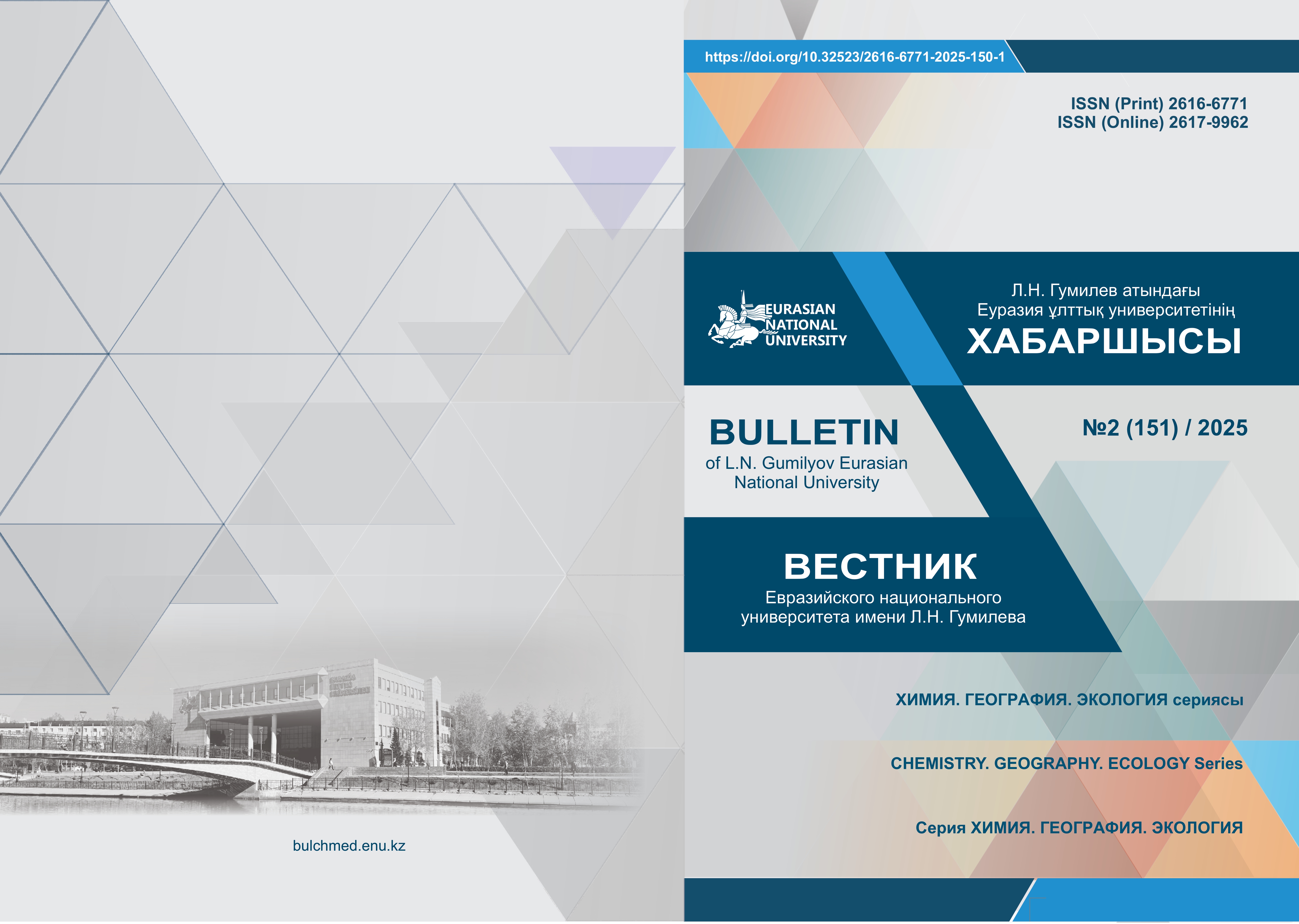Есіл өзені бассейнінің тұрақты дамуы: сектораралық тәсіл және сценарийлік талдау
Қаралымдар: 447 / PDF жүктеулері: 116
DOI:
https://doi.org/10.32523/2616-6771-2025-151-2-237-254Кілт сөздер:
тұрақты даму, су ресурстарын басқару, су ресурстарын аумақтық қайта бөлу, тұрақты ауыл шаруашылығы, шағын су электр станцияларыАңдатпа
Есіл өзенінің бассейні – Қазақстанның солтүстік және орталық аймақтарындағы маңызды өнеркәсіптік-аграрлық өңір, мұнда ауыл шаруашылығы басым. Бассейнде жылдық ағын су көлемінің жоғары өзгергіштігі және су ресурстарының біркелкі бөлінбеуі байқалады, бұл суды тұрақты дамудың басты факторы етеді. Су тапшылығының артуы, ластану, су ресурстарын тиімсіз басқару және әсіресе Астана қаласындағы су тұтынудың өсуі аймақтың әлеуметтік-экономикалық және экологиялық тұрақтылығына қатер төндіреді. Бұл зерттеу Есіл өзенінің бассейні үшін алғаш рет интеграцияланған сценарийлік талдауды ұсынады. Ұсынылған шаралар Ертіс өзенінен жылына 1,5 км3 дейін су тасымалдауды, Бұзылык су қоймасын салуды, суармалы егістікті кеңейтуді және шағын су электр станцияларын дамытуды қамтиды. Бұл шаралар экоинженерлік тәсіл негізінде өңірдің тұрақтылығын арттыруға бағытталған. Нәтижелер көрсеткендей, ұсынылған шаралар су, азық-түлік және энергия қауіпсіздігін нығайтады және Қазақстанның декарбонизациялау мақсаттарына сәйкес келеді. Болашақ зерттеулер экологиялық әсерді бағалауды, әлеуметтік-экономикалық орындылықты және мүдделі тараптардың қатысуын қамтуы тиіс.
Downloads
Әдебиеттер тізімі
Kazgiprovodkhoz Institute. (2006). The scheme of integrated use and protection of water resources of the Ishim River basin in the territory of the Republic of Kazakhstan (Skhema kompleksnogo ispol'zovaniya i ohrany vodnyh resursov bassejna reki Ishim na territorii Respubliki Kazahstan in Russian). Almaty, Kazakhstan: Kazgiprovodkhoz Institute.
Republican State Enterprise on the Right of Economic Management «Kazhydromet». (2023). State Water Cadaster of the Republic of Kazakhstan: Annual data on the regime and resources of land surface waters for 2021 (Gosudarstvennyj vodnyj kadastr Respubliki Kazahstan: Ezhegodnye dannye o rezhime i resursah poverhnostnyh vod sushi za 2021 god in Russian). Astana, Kazakhstan: Kazhydromet. https://www.kazhydromet.kz/en/gidrologiya/basseyn-reki-esil-2002-2021
Ministry of Ecology and Natural Resources of the Republic of Kazakhstan. (2021). National report on the state of the environment and on the use of natural resources of the Republic of Kazakhstan for 2020 (Nacional'nyj doklad o sostoyanii okruzhayushchej sredy i ob ispol'zovanii prirodnyh resursov Respubliki Kazahstan za 2020 god in Russian). https://www.gov.kz/memleket/entities/ecogeo/documents/details/243132?lang=ru
Bureau of National Statistics of the Agency for Strategic Planning and Reforms of the Republic of Kazakhstan. (2023). Gross harvest of agricultural crops in the Republic of Kazakhstan for 2022. https://stat.gov.kz/ru/industries/business-statistics/stat-forrest-village-hunt-fish/publications/5099/
Ali, S. M., & Acquaye, A. (2024). An examination of the water-energy-food nexus: From theory to application. Renewable and Sustainable Energy Reviews, 202, 114669. https://doi.org/10.1016/j.rser.2024.114669
Bazilian, M., Rogner, H., Howells, M., Hermann, S., Arent, D., Gielen, D., Steduto, P., Mueller, A., Komor, P., Tol, R. S. J., & Yumkella, K. K. (2011). Considering the energy, water and food nexus: Towards an integrated modelling approach. Energy Policy, 39(12), 7896-7906. https://doi.org/10.1016/j.enpol.2011.09.039
Zeng, Y., Liu, D., Guo, S., Xiong, L., Liu, P., Chen, J., Chen, H., Yin, J., Wu, Z., & Zhou, W. (2024). Assessment of the impacts of water resources allocation on the reliability, resilience and vulnerability of the water–energy–food–society (WEFS) nexus system. Agricultural Water Management, 295, 108780. https://doi.org/10.1016/j.agwat.2024.108780
Scientific Information Center of the Interstate Coordinating Water Management Commission of Central Asia. (2016). The general scheme of integrated use and protection of water resources of the Republic of Kazakhstan. Tashkent, Uzbekistan: SIC ICWC.
Amanov, O. A., & Shojmuradov, A. (2019). The effect of irrigation standards on the quality of durum wheat grain (Vliyanie norm poliva na kachestvo zerna tvyordoj pshenicy in Russian). Innovacionnaya nauka, 7-8. https://cyberleninka.ru/article/n/vliyanie-norm-poliva-na-kachestvo-zerna-tvyordoy-pshenitsy
Golubova, V., & Gaze, V. (2022). Evaluation of seed resistance of winter durum wheat varieties to lack of moisture and overheating. In XV International Scientific Conference «INTERAGROMASH 2022» (pp. 395-403). Lecture Notes in Networks and Systems (Vol. 575). Springer. https://doi.org/10.1007/978-3-031-21219-2_42
Purwanto, A., Sušnik, J., Suryadi, F.X., & de Fraiture, C. (2021). Water-energy-food nexus: Critical review, practical applications, and prospects for future research. Sustainability, 13(4), 1919. https://doi.org/10.3390/su13041919
Rivotti, P., Karatayev, M., Sobral Mourão, Z., Shah, N., Clarke, M.L., & Konadu, D.D. (2019). Impact of future energy policy on water resources in Kazakhstan. Energy Strategy Reviews, 24, 261-267. https://doi.org/10.1016/j.esr.2019.04.009
Subbotin, A. S., & Khaustov, V. A. (2012). Hydraulic engineering and land reclamation (Gidrotekhnicheskoe stroitel'stvo i melioraciya zemel' in Russian). St. Petersburg, Russia: Russian State Hydrometeorological University.
Жүктеулер
Жарияланды
Журналдың саны
Бөлім
Лицензия
Авторлық құқық (c) 2025 T. Dentinho, G. Saspugayeva, A. Zhaken (Author)

Бұл жұмыс Creative Commons Attribution-Коммерциялық емес 4.0 халықаралық лицензиясы.








